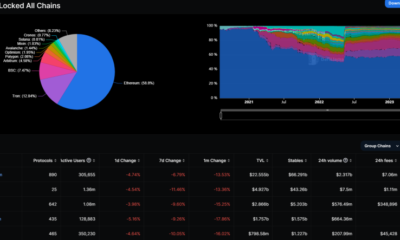Politics
DDoS Can Cripple a Blockchain, What Does This Mean to the Cryptocurrency Ecosystem – ReadWrite
Published
3 years agoon
By
Drew Simpson
Over two decades old, blockchain has become the actual foundation for mining, security, and the creation of cryptocurrency. It is dependable, trusted, and widely used for multiple forms of digital currency around the world.
DDoS Can Cripple a Blockchain
Merely due to its digital nature, blockchain is susceptible to attack and exploitation. One of the most dangerous threats to blockchain is distributed denial of service attacks.
However, even when vulnerabilities exist, networks and users can find ways to prevent harm to blockchain transactions and information.
As we discuss here — you will want to protect yourself and your organization proactively.
What is Blockchain and How Does This Technology Work?
While complicated, blockchain generally boils down to a specific type of database. This is a way to store information in blocks chained together. These blocks are chronological in order and increase as fresh data comes into the blockchain.
The blockchain type of data transaction has no central authority and provides group access through decentralization.
Decentralized blockchains are irreversible transactions, so once the data is within the database, it cannot be changed.
Blockchain is a trustworthy transaction, secure from outside sources, and moves quickly throughout various networks worldwide.
Unlike other forms of currency, there is no physical representation to a blockchain, as it is only data. However, it can also store the history of cryptocurrency transactions, legally binding contracts, and inventories of various products.
How Blockchain is Built-In Bitcoin Mining
Cryptocurrency mining occurs through a process with computers solving intricate mathematic problems.
The mining of bitcoin and other cryptocurrencies occurs through these processes, and transactions combine with similar ones and are then transmitted to all nodes. This enacts an update to the associated ledgers.
New currency is possible through rewards given once the computers solve the mathematical computations. The mining involved with bitcoin creates blocks of data with these transactions, which eventually create blockchains. These are large and long sequences of mined transactional data.
The nodes will confirm trusted data and verify the information within the blockchain. Through checks and balances with these processes, the blockchain can consistently maintain integrity. The inherent integrity in the system ensures trust in the bitcoin mined through the blockchain.
Why is Blockchain Considered the Base of Cryptocurrency “Unhackable?”
Blockchain utilizes multiple sources of defense against hackers to prevent attacks and to assist in reducing the costs of damage once a cyber threat like a DDoS attack occurs.
Blockchain was once considered unshakable because the data is immutable or irreversible once entered. In addition, it is decentralized with no individual authority such as a bank or government. Additional protocols also identify and report potential threats to the blockchain in use.
The decentralization specifically reduces various risks to the data and limits fees with transactions and processing of the data. Blockchain accomplishes this by spreading processing power over multiple computers in a network.
How a DDoS attack can Cripple Blockchain
Related to the DDoS attacks on EXMO, blockchain has some vulnerabilities regarding DDoS attacks. These include the following:
- Blockchain nodes: Blockchains exist on nodes that update with the latest data and are all connected.
- Smart contracts: Blockchain programs run through predetermined conditions met within the blockchain.
- Consensus mechanisms: There are three consensus mechanisms. The Proof of Work or PoW, the Proof of Stake or PoS. and the Delegated Proof of Stake or DPoS. These all generally confirm the deletion of equivalent data within the blockchain.
- Wallets: A digital wallet provides access to, storage, and management of cryptocurrency such as bitcoin.
The 51 percent attack happens when a hacker or other malicious user injects data with over 50 percent of the network processing power or hash rate. When the attacker does this, it is possible to overtake chains of data that do not go to the intended party.
Another side effect is the hacker can copy the data and add it to the chan. This then will delete previous information, so the block never saw it.
The perpetrator of the attack will use a DDoS to infiltrate some of these vulnerabilities and steal access to blockchain data and transactions such as bitcoin. For example, 51 percent of attacks (seba dot swiss) led to losses of over $1.1 million with Ethereum Classic in 2019, nearly $2 million with Verge in 2018, and another 2018 Verge attack with just over $1 million.
What is a DDoS Attack, and How Does it Target Blockchain and Make it Prone to Hacking?
Someone with malicious intent such as a hacker can flood a server, single network, or multiple networks with various requests or additional traffic leading to a Distributed Denial of Service or DDoS. Usually, the individual or group responsible wants to either slow the system or cause an entire collapse.
Once a DDoS starts on one computer, it will spread to others in the same network, leading to catastrophic failure.
The vulnerabilities of blockchain through nodes, contracts, or wallets can lead to overutilization of processing power within the server or network. The overutilization then causes a loss of connectivity with cryptocurrency exchanges or other applications connected at the time.
The perpetrator of these attacks can start by tracking IP addresses with specific locations around the world.
The DDoS attacks on EXMO led to the British servers going offline. This caused the website to go down and the servers’ inability to run during the aftermath of the attack. Additionally, hot wallets were compromised during this event, and the perpetrators withdrew five percent of all assets involved.
EXMO explained that they would cover all losses after suspending every withdrawal at the time. This led to new infrastructure development with a separate server for hot wallets.
What Does This Mean to the Crypto-Market?
The Crypto-Market often fluctuates. Based on word of mouth, the value changes, information that can help or harm the influence of various cryptocurrencies, and damage through DDoS attacks that can lead to financial losses. Because these malicious users can cause websites, servers, or networks to go offline for indeterminate amounts of time, the Crypto-Market can see dips in investment and reliability of financial transactions.
Often, after a DDoS attack, the blockchain development may change focus or utilize new techniques that decrease the possibility of vulnerabilities.
After a DDoS Attack, What is its Implication for the Crypto Market and Bitcoin Specifically?
Cryptocurrency markets grew from $19 billion to $602 billion from the beginning of 2017 to the end of 2017. Volume trade with these markets and even the negative effects of DDoS attacks are normally mitigated within the same day the damage occurs. However, malicious users can affect the market through Twitter feeds, news through Google Searches, and the status pages of the network.
How Does a DDoS Attack Affect the Bitcoin Ecosystem?
The trade of Bitcoin will fluctuate based on the downtime of the servers or websites associated with the cryptocurrency. In addition, offline websites affect the access to trades, the ability to purchase or sell, and access to Bitcoin.
Additionally, if someone influential says something through social media, the market can suffer a downtrend or an uptrend based on positive or negative reviews of Bitcoin. This generally leads to either more buying of the cryptocurrency or fewer purchases.
Once the market is affected by these trends, the prices will change. For example, mass-selling may occur after a DDoS attack if there are numerous users affected by a loss of financial transactions. This is even possible if the company behind the Bitcoin data reimburses users for these losses.
Can a Cyber-Attack Change the Market from Bull to Bear?
The general statistical trend of the crypto-market appears little affected by the negative effects of DDoS attacks.
Websites are normally back up and online within the same day. Trades, purchasing, and selling cryptocurrency are not usually severely impacted by most cyber-attacks. Bitcoin, in particular, has few patterns that explain the bull and bear rise and fall of prices.
However, multiple cyberattacks targeting one website, server, or network can lead to sustained losses for the company. The loss of faith in the downtime from the attack can lead to a bear market where losses are constant for a period of time.
What Cybersecurity Measures Should be Taken to Prevent a DDoS Attack?
To prevent similar DDoS attacks such as those that occurred on EXMO and other companies, you can put numerous cybersecurity measures in place.
Prevention is key. There are several ways to prevent DDoS and other cybersecurity attacks.
- Develop a Denial of Service plan by assessing security risks and what to do in case an attack ever occurs.
- Enhance network infrastructure security for multi-level protection protocols.
- Minimize user errors and security vulnerabilities.
- Develop a strong network architecture by focusing on redundant resources within the network and servers.
- Utilize the cloud to spread out the attack and use multiple environments to prevent damage within the system.
- Recognize common warning signs of DDoS attacks, such as increased traffic, intermittent connectivity, and a lack of standard performance.
- Consider investing in DDoS-as-a-Service, which can provide flexibility, third-party resources, and cloud or dedicated hosting on multiple types of servers at the same time.
It is imperative to identify and then respond to attacks in real-time.
By using checkboxes, captcha and other methods on the website, programs and users can discover if the activity is real or a potential threat. In addition, changing response times through automation, recognizing patterns of attack, and implementing defense systems can all provide measures of protection.
Automation of attack detection can reduce DDoS response time against the attack.
The automation method provides near-instant detection for incoming DDoS attacks.
When traffic spikes to untenable levels, automation can redirect traffic through an automated defense system. This system is usually adaptive and can employ various methods if the DDoS event is different from the previous attacks.
Automation can identify patterns in traffic by sifting through a large amount of data quickly. This can provide real-time solutions during the attack. The defense system of automation can also access IP blocklists and weapons to protect certain zones of information.
Automated defense systems provide adaptable solutions for the ever-evolving hacker intent on stealing data. With real-time updates and access to lists the company or user may not have, network administrators can implement strategies to prevent or mitigate the damage caused at the attack time.
New Trends in Protecting Against DDoS Attacks
A new cybersecurity trend involves awarding cryptocurrency to users that spot irregular activity and report the issue. Previous and continuing trends involve tracking the deviation in traffic. Some companies will use software to analyze answers to queries, determine if transactions are legitimate, and evaluate if processes are in line with true activity. This can single out bots or malicious traffic.
Pattern recognition is important when determining whether a DDoS attack is underway.
Companies can use machine learning technology to detect irregular patterns. For example, a query can help to determine which IP addresses, timeframes, or accounts are affecting the network during a DDoS attack.
Do this early — and well to guard against attacks.
Another trend to guard against DDoS attacks identifying IP addresses commonly associated with DDoS attacks and blocking them.
Some companies use forensic tools after a data breach or DDoS attack to determine how the attack occurred and how to respond to a similar one in the future. This may involve using programs and encrypted recorded logs to review later.
Conclusion
It is vital to stay alert to potential threats. By always being prepared for potential disasters, you should be able to prevent catastrophe.
Having a plan in place when the attack happens can limit response time to prevent the website or network from going offline.
To accomplish these goals, you can implement stronger cybersecurity measures and invest in resources that recognize various DDoS patterns and alert users immediately to take direct action. These proactive steps can help protect blockchain data and keep cryptocurrency from falling into malicious hands.
Ben Hartwig
Ben is a Web Operations Director at InfoTracer who takes a wide view from the whole system. He authors guides on entire security posture, both physical and cyber. Enjoys sharing the best practices and does it the right way!
You may like
-


2023 global cloud ecosystem
-


Why Hong Kong is still bullish on crypto
-


How Can Blockchain Technology Revolutionize ATM Security?
-


New Cryptocurrency Launches to Invest in for August 2023
-


Cryptocurrency and Blockchain Security: Challenges and Solutions
-


Crypto Trading and Its Impact: Understanding the World of Cryptocurrency
Politics
Fintech Kennek raises $12.5M seed round to digitize lending
Published
7 months agoon
10/11/2023By
Drew Simpson
London-based fintech startup Kennek has raised $12.5 million in seed funding to expand its lending operating system.
According to an Oct. 10 tech.eu report, the round was led by HV Capital and included participation from Dutch Founders Fund, AlbionVC, FFVC, Plug & Play Ventures, and Syndicate One. Kennek offers software-as-a-service tools to help non-bank lenders streamline their operations using open banking, open finance, and payments.
The platform aims to automate time-consuming manual tasks and consolidate fragmented data to simplify lending. Xavier De Pauw, founder of Kennek said:
“Until kennek, lenders had to devote countless hours to menial operational tasks and deal with jumbled and hard-coded data – which makes every other part of lending a headache. As former lenders ourselves, we lived and breathed these frustrations, and built kennek to make them a thing of the past.”
The company said the latest funding round was oversubscribed and closed quickly despite the challenging fundraising environment. The new capital will be used to expand Kennek’s engineering team and strengthen its market position in the UK while exploring expansion into other European markets. Barbod Namini, Partner at lead investor HV Capital, commented on the investment:
“Kennek has developed an ambitious and genuinely unique proposition which we think can be the foundation of the entire alternative lending space. […] It is a complicated market and a solution that brings together all information and stakeholders onto a single platform is highly compelling for both lenders & the ecosystem as a whole.”
The fintech lending space has grown rapidly in recent years, but many lenders still rely on legacy systems and manual processes that limit efficiency and scalability. Kennek aims to leverage open banking and data integration to provide lenders with a more streamlined, automated lending experience.
The seed funding will allow the London-based startup to continue developing its platform and expanding its team to meet demand from non-bank lenders looking to digitize operations. Kennek’s focus on the UK and Europe also comes amid rising adoption of open banking and open finance in the regions.
Featured Image Credit: Photo from Kennek.io; Thank you!
Radek Zielinski
Radek Zielinski is an experienced technology and financial journalist with a passion for cybersecurity and futurology.
Politics
Fortune 500’s race for generative AI breakthroughs
Published
7 months agoon
10/11/2023By
Drew Simpson
As excitement around generative AI grows, Fortune 500 companies, including Goldman Sachs, are carefully examining the possible applications of this technology. A recent survey of U.S. executives indicated that 60% believe generative AI will substantially impact their businesses in the long term. However, they anticipate a one to two-year timeframe before implementing their initial solutions. This optimism stems from the potential of generative AI to revolutionize various aspects of businesses, from enhancing customer experiences to optimizing internal processes. In the short term, companies will likely focus on pilot projects and experimentation, gradually integrating generative AI into their operations as they witness its positive influence on efficiency and profitability.
Goldman Sachs’ Cautious Approach to Implementing Generative AI
In a recent interview, Goldman Sachs CIO Marco Argenti revealed that the firm has not yet implemented any generative AI use cases. Instead, the company focuses on experimentation and setting high standards before adopting the technology. Argenti recognized the desire for outcomes in areas like developer and operational efficiency but emphasized ensuring precision before putting experimental AI use cases into production.
According to Argenti, striking the right balance between driving innovation and maintaining accuracy is crucial for successfully integrating generative AI within the firm. Goldman Sachs intends to continue exploring this emerging technology’s potential benefits and applications while diligently assessing risks to ensure it meets the company’s stringent quality standards.
One possible application for Goldman Sachs is in software development, where the company has observed a 20-40% productivity increase during its trials. The goal is for 1,000 developers to utilize generative AI tools by year’s end. However, Argenti emphasized that a well-defined expectation of return on investment is necessary before fully integrating generative AI into production.
To achieve this, the company plans to implement a systematic and strategic approach to adopting generative AI, ensuring that it complements and enhances the skills of its developers. Additionally, Goldman Sachs intends to evaluate the long-term impact of generative AI on their software development processes and the overall quality of the applications being developed.
Goldman Sachs’ approach to AI implementation goes beyond merely executing models. The firm has created a platform encompassing technical, legal, and compliance assessments to filter out improper content and keep track of all interactions. This comprehensive system ensures seamless integration of artificial intelligence in operations while adhering to regulatory standards and maintaining client confidentiality. Moreover, the platform continuously improves and adapts its algorithms, allowing Goldman Sachs to stay at the forefront of technology and offer its clients the most efficient and secure services.
Featured Image Credit: Photo by Google DeepMind; Pexels; Thank you!
Deanna Ritchie
Managing Editor at ReadWrite
Deanna is the Managing Editor at ReadWrite. Previously she worked as the Editor in Chief for Startup Grind and has over 20+ years of experience in content management and content development.
Politics
UK seizes web3 opportunity simplifying crypto regulations
Published
7 months agoon
10/10/2023By
Drew Simpson
As Web3 companies increasingly consider leaving the United States due to regulatory ambiguity, the United Kingdom must simplify its cryptocurrency regulations to attract these businesses. The conservative think tank Policy Exchange recently released a report detailing ten suggestions for improving Web3 regulation in the country. Among the recommendations are reducing liability for token holders in decentralized autonomous organizations (DAOs) and encouraging the Financial Conduct Authority (FCA) to adopt alternative Know Your Customer (KYC) methodologies, such as digital identities and blockchain analytics tools. These suggestions aim to position the UK as a hub for Web3 innovation and attract blockchain-based businesses looking for a more conducive regulatory environment.
Streamlining Cryptocurrency Regulations for Innovation
To make it easier for emerging Web3 companies to navigate existing legal frameworks and contribute to the UK’s digital economy growth, the government must streamline cryptocurrency regulations and adopt forward-looking approaches. By making the regulatory landscape clear and straightforward, the UK can create an environment that fosters innovation, growth, and competitiveness in the global fintech industry.
The Policy Exchange report also recommends not weakening self-hosted wallets or treating proof-of-stake (PoS) services as financial services. This approach aims to protect the fundamental principles of decentralization and user autonomy while strongly emphasizing security and regulatory compliance. By doing so, the UK can nurture an environment that encourages innovation and the continued growth of blockchain technology.
Despite recent strict measures by UK authorities, such as His Majesty’s Treasury and the FCA, toward the digital assets sector, the proposed changes in the Policy Exchange report strive to make the UK a more attractive location for Web3 enterprises. By adopting these suggestions, the UK can demonstrate its commitment to fostering innovation in the rapidly evolving blockchain and cryptocurrency industries while ensuring a robust and transparent regulatory environment.
The ongoing uncertainty surrounding cryptocurrency regulations in various countries has prompted Web3 companies to explore alternative jurisdictions with more precise legal frameworks. As the United States grapples with regulatory ambiguity, the United Kingdom can position itself as a hub for Web3 innovation by simplifying and streamlining its cryptocurrency regulations.
Featured Image Credit: Photo by Jonathan Borba; Pexels; Thank you!
Deanna Ritchie
Managing Editor at ReadWrite
Deanna is the Managing Editor at ReadWrite. Previously she worked as the Editor in Chief for Startup Grind and has over 20+ years of experience in content management and content development.
